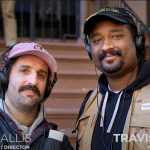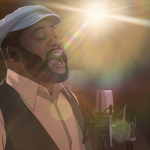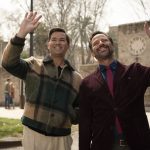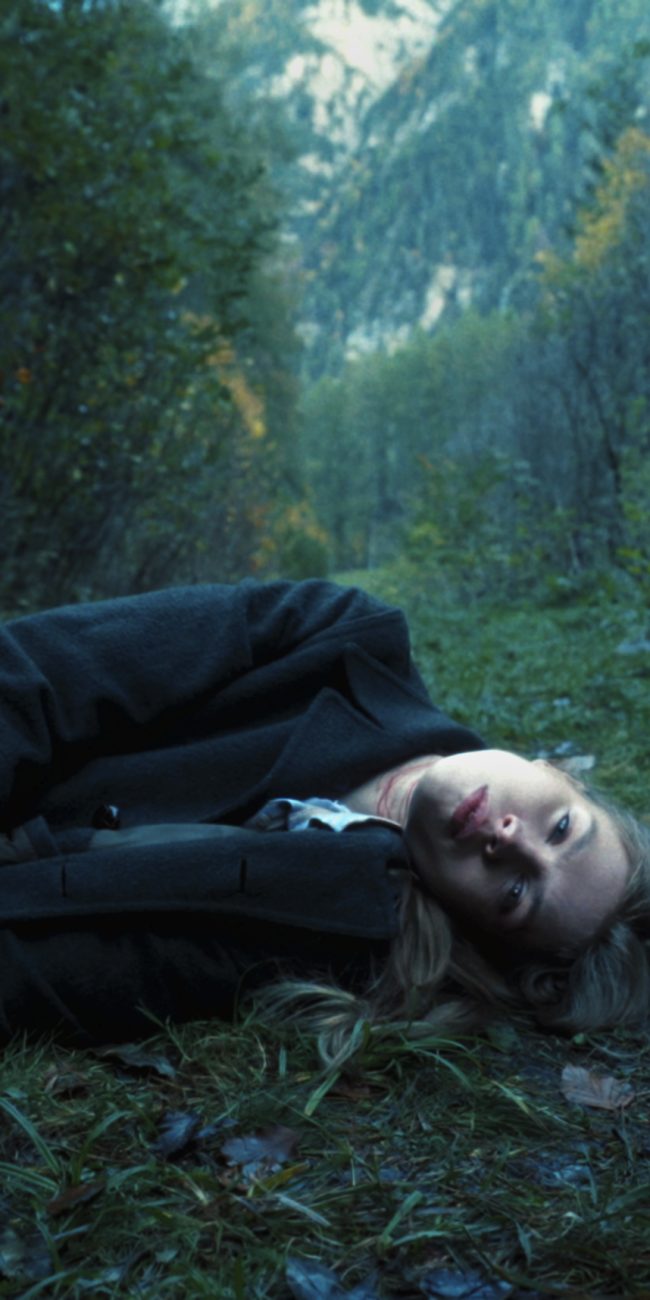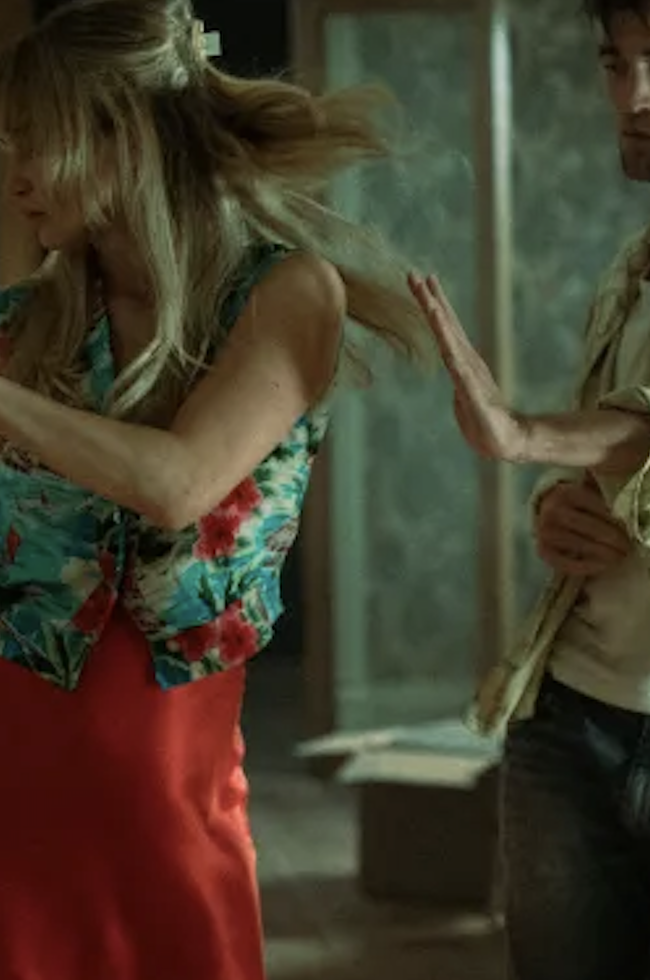A Conversation with Michael Tyburski (TURN ME ON)
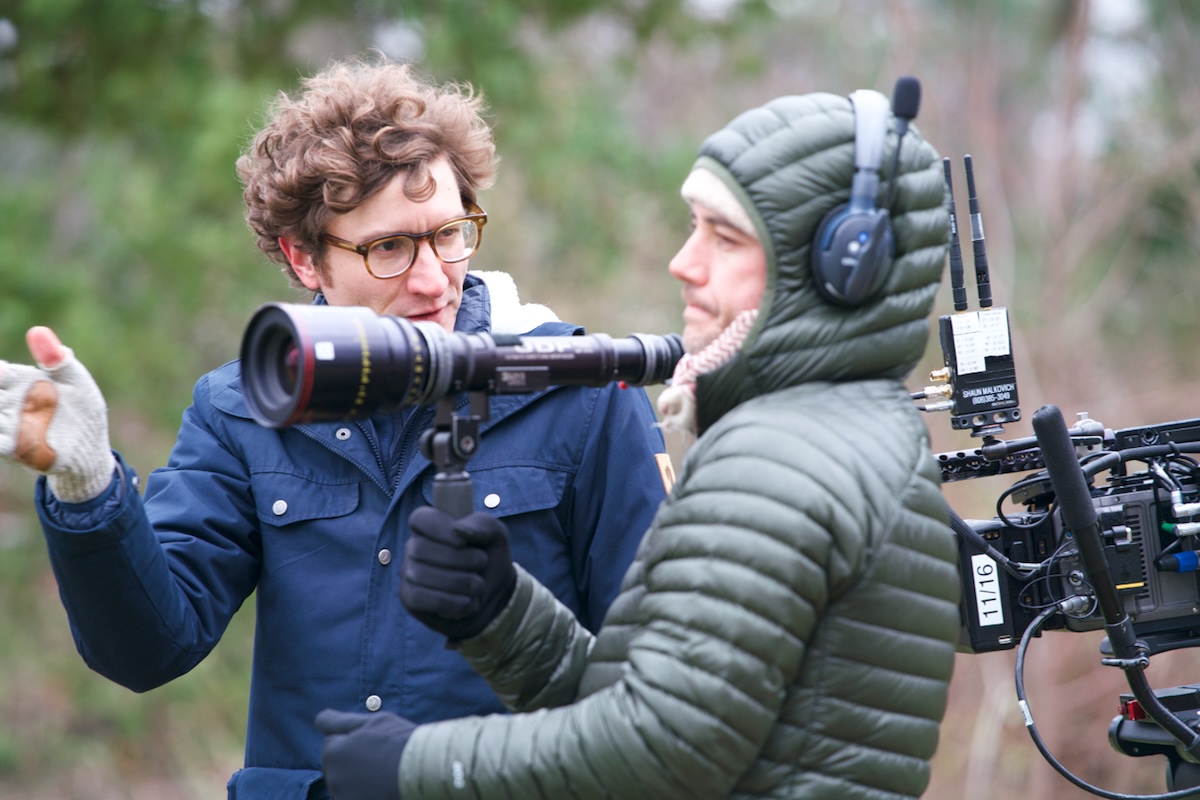
Director Michael Tyburski’s latest feature, Turn Me On, (which I recently reviewed), is set in a near-future dystopia, where ostensibly messy emotions are suppressed via a daily intake of pills. The residents of the strange, antiseptic compound run by “Our Friends”—a shadowy organization whose true motives remain a mystery—are there voluntarily, yet are unable to leave. Starring Bel Powley (Wilding) and Nick Robinson (Silk Road), among others, the movie follows what happens after one stops taking the drugs. I recently had a chance to speak with Tyburski—who won Hammer to Nail’s Spring 2015 Shorts Contest with his Actor Seeks Role—via Zoom, and here is that interview, edited for length and clarity.
Hammer to Nail: How did the script, by Angela Bourassa, come to you and was it called Turn Me On at that point?
Michael Tyburski: The script was sent to me by the producers. The time is important: it was during the summer of 2020, so right in the early part of the pandemic. It was called Turn Me On and it was sent to me to see if I was interested in directing it. And at the time I was looking for material that was already written that I could direct. I’m a writer—that’s how I developed my first feature—but there was a part of me that just wanted to direct something again sooner; it takes me a long time to develop a project from the beginning. I was interested in experimenting with adapting someone else’s written material. That first draft of the script was not universally different from the final version but there was quite an adaptation that happened in that moment of me receiving it to working with Angela.
She stayed the writer—she’s always been the writer on the project—but I wanted to make it a little bit more adapted to my sensibilities and what I thought would be interesting on screen, and also to make it within the scope of what we had in terms of budget. Her original script was written as a more traditional science-fiction movie that took place in a futuristic city with a lot more futuristic technology. And while those things were interesting, I knew we didn’t have the infrastructure to actually build that. So I pared it down to what I thought was more interesting visually and that felt more unique, while also staying true to the core of her story. At the end of the day, outside of the science fiction of it all, it’s a story about the human condition.
HtN: Did you keep a lot of the basic structure beyond the sci-fi, which you altered? You’ve got the main couple and these two supporting couples, for example.
MT: It was her story but I found my way into it. I was compelled by that central narrative. I would say we actually did quite a bit of maneuvering for the reasons I just mentioned; for instance, adapting Joy’s (the Bel Powley character’s) job, which was completely different in the script, where she worked at something that we did not have the capacity to make. But also that led to us inventing essentially an entire character in a backstory that didn’t exist. So there was Griffin Newman’s character, Frank, and the story was that there was a character who had some of his character arc but did not have a backstory. We did not see him, before, entering this community.
And that’s something that I thought was really important because this movie was never designed to have a twist ending. It has left turns, but it wasn’t a big kind of reveal, so to speak. So I wanted to get that exposition and that world-building out of the way in a manner that felt honest or organic at the top of the film. So that kind of birthed that character. And then that linked into re-imagining Joy’s job and what she did and linking it to that.
HtN: Speaking of these science-fiction elements that you chose to adapt to your own sensibility, one of my favorite aspects of your film is the production design; it’s really quite evocative. I really like, for example, that large living space where the three couples hang out. Did you build all your sets? Did you use some form of established locations and tweak them? Or was it a combination of both?
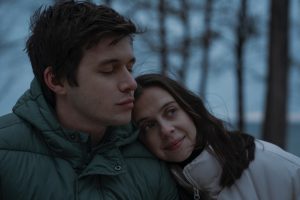
A still from TURN ME ON
MT: I love talking about production design. I worked with a great production designer, Annie Simeone Morales, and we knew, based on our budget, that we weren’t going to have a lot of original builds. So it’s a combination of both, to answer that part of the question. But we found locations that we could augment with her own kind of semi-builds. It doesn’t feel like a VFX film, but there’s a lot of lo-fi VFX that we did.
We certainly did a lot for the exteriors; we did a lot of things called digital matte paintings where we replaced the core bones of this main campus to make it feel like it was in the middle of the woods or secluded. We looked for locations that felt a little bit timeless, but also from a different era; from a past era, even though some of this technology is futuristic, right? The devices they use—the actual vitamins—these are the science-fiction elements.
We shot in this area near Rochester, New York, in the western part of the state where there’s a lot of architecture that was built in the 1960s. And the interiors are very ‘70s-heavy, which I love. We worked in the old Kodak headquarters, which are mostly abandoned now. And that aesthetic was something we wanted to lean into. So we used the bones of those places and then we built our sets around those. We brought in material, different furniture, walls in some cases, but it was all to adapt to these very specific locations from those eras that felt right for the world of this film and that just felt tactile and a little bit nostalgic.
HtN: Well, I love the look. And speaking of an aesthetic choice, I’m curious about your decision to have the history of the world outside the compound feel like it comes from a 1950s perspective. I’m thinking of the films that Bel Powley’s character, Joy, watches later. Why did you choose that era?
MT: So this is not in the movie, but when you write a script and you adapt it, you have to create rules and backstories for yourself and for the production-design team. So in that scene that you’re referencing, Joy has now been promoted to the “Our Friends” track. So she’s working with the founders, the organizers, the powers that be of this strange world. And it’s a bit of smoke and mirrors for her where she’s being presented as if she’s getting the world’s knowledge, but we wanted to keep it as if they’re still censoring her in some way. And we like to think that the origins of this community maybe go back to one of those eras where the idea of all the materials she’s watching—which is mostly black-and-white and dated and these old kinds of educational films, and you have the Jimmy Stewart/Carole Lombard movie—is that they want her to have access but not to overwhelm her. So the idea is that they’re very much still manipulating and controlling the type of content she digests. They want to keep her in a certain safer mindset when they believe maybe certain values were right in the world.
HtN: What is that Jimmy Stewart/Carole Lombard film?
MT: It’s Made for Each Other, from 1939. It was just this kind of amazing discovery. I knew I wanted a film from that era, and that happens to be a film that’s kind of gotten lost to time and is in between weird legal disputes in terms of who owns the copyright to it. So essentially it was not the most difficult thing to be able to use, but it felt like this gem when I found it.
HtN: So let’s talk about the cast. Bel Powley is amazing as Joy, as is Nick Robinson. Griffin Newman, also. Everyone does a good job. I think you had Bel Powley first, right? So how did that happen and then how did the rest of the cast come aboard?
MT: Yeah, it’s essentially Bel’s story—her character Joy’s story—which to me would be a great alternate title for this movie if I had my way. But I think that title has already been used.
HtN: Right. David O. Russell had a previous movie, Joy.
MT: That was from Angela’s script, the irony of her name. And I just thought that was always the perfect metaphor for this movie. So, she came on it, and the way indie financing goes on features of this size—and all movies, really—is that there are a lot of starts and stops and they take a while. So I had the luxury (I look at it that way) where Bel was attached to the movie something like two years before we rolled cameras. So we got to talk a lot about her character and she was just someone I jived with right away. Rehearsing, to me, is usually just having conversations with my cast and getting to know them and understanding that’s a time to ask questions and figure things out together.
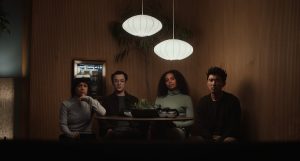
A still from TURN ME ON
Nick came on around that same period, and he was just someone I loved. I think I was particularly attracted to some of the more recent dramatic work he had done at the time. There’s a great series that I saw when I was looking at him called A Teacher, where I thought he was so compelling and I didn’t see him getting cast a lot in more challenging roles. And he was someone who, when I talked to him about the role, he just kind of completely got the vision that I was going for.
And for everyone else I worked with this great casting team whom I worked with on my first feature, Rori Bergman and Karlee Fomalont, and they know my tastes very well and they’re just terrific casting directors in New York who brought me new names that I wasn’t as familiar with to help fill in the rest of the cast. And I fell in love with every single one of them.
HtN: Speaking of Griffin Newman, years ago I met his parents at a film festival and then I ended up interning for Peter Newman when he was working with Ira Deutchman. It makes me feel old to think about that because he must’ve been a very young kid when I met Peter and Antonia, his mother. I guess he’s in his thirties now and has that podcast.
MT: Yes, Blank Check. I’m fascinated by the whole Newman family. They’re all amazing. Griffin, I should say, is the one person I really championed and I sought him out. That was also the role that I kind of developed with Angela and I developed it, admittedly, for Griffin. I really wanted to work with him. I was not aware—I’m in the minority and now I’m a big fan of his podcast—but it was not on my radar. But I originally found him because he guested on this very nerdy podcast that I listened to, which is about theme parks, called Podcast: The Ride, though I had also seen some of his acting work.
But I knew he was someone I wanted to be friends with because we could also talk about our fascination with the history of, specifically Disneyland, but all kinds of early theme parks. I’m obsessed with Epcot Center and I have my own sort of homages to that in this film and the origins of this world. So after making the film and working on this character with Griffin, we premiered at San Sebastian Film Festival last fall, and then he and I just wanted to do something to celebrate; we wanted to do something frivolous. So we went to Euro Disney—or Disneyland Paris, as it were—right after the festival and just had a great theme-park day together, and it felt like the perfect culmination to the end of this experience of meeting each other based on our fascination with this subculture. And the roots of Epcot Center and the original Walt Disney idea for what that was going to be, like a living, working city, were really inspirational to aspects of the film that I added to the script. We use some of that language in that Luke Kirby orientation video that Griffin’s characters watches, to add a kind of subtle wink to the origins of what became Epcot Center, the theme park.
HtN: That really helps explain the aesthetic of the world. Michael, thank you so much for talking to me!
MT: Thank you so much. This was great.
– Christopher Llewellyn Reed (@ChrisReedFilm)
Turn Me On; Michael Tyburski

